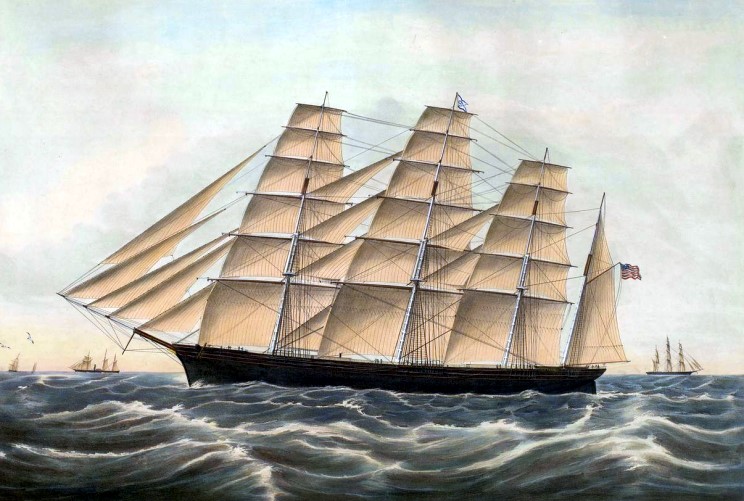She is described as the master work of Donald McKay, a ship 335' long and 4,555 gross tons, the largest
merchant ship built in America to date. Her beauty was augmented with stained glass windows and a luxurious
interior designed to be the finest in the business. McKay not only built the ship, he was it's owner as well. It
was built on speculation, but he had not sold it before it's maiden voyage.
She was launched with much fanfare on Oct. 4, 1853, an estimated 30,000 people came to the east side of
Boston to see the ship glide into the water. She was fitted out, her four masts were raised and rigged with
15,653 square feet of sail and
she was towed to New York and loaded with $300,000 of cargo for her maiden
voyage to Liverpool. She arrived in the last week in November and apparently was a huge success with the
public. An estimated 40,000 people paid .12½¢ each for the privilege of touring the ship. (The ½ penny coin
was minted until 1857.)
At 1 a.m. on Dec. 27, 1853 a small fire started at Tredwell & Sons' Novelty Bakery at 242 Front Street, soon,
driven by the wind the whole of Front street was aflame, soon followed by buildings on Water street to the
north, this area is where the Brooklyn bridge intersects with FDR drive now.
As the fire progressed it encompassed buildings between Water street to the north and South street along the
East River, where several ships were docked. The embers from the fire were caught in the sails and soon the
Great Republic was ablaze. Two other ships, the 1,118 ton clipper White Squall, owned by Platt & Sons of
Philadelphia the 1,315 ton packet Joseph Walker of the Black Star Line were also burning. Both these ships
were built in New York, the former by Jacob Bell and the latter by William H. Webb.
By 3 a.m. the Great Republic was in flames from stem to stern, the crew cut away her masts and even scuttled
her in an attempt to save her, but all her upper works were burned away. When the calamity was over the Great
Republic lay in 25' of water and a total wreck. McKay settled with the insurance companies and sold the ship
to A. A. Low & Brother of New York.
She was rebuilt at Sneeden & Whitlock, but with only 3 decks and much reduced sail area and her tonnage was
reduced to 3,357 tons. She would finally make her maiden voyage in 1855, but not before another problem.
On Jan. 23, 1855 a boiler for the steam engine exploded while at New York, several people were injured, the
engineer, Jacob Tronte, was scalded from head to toe, reports at the time stated "it is doubtful he will recover".
I was unable to learn if he did or not. This steam engine was a first on a sailing ship, it was used to load and
unload cargo, raise the sails and could even be used as an auxiliary engine if the wind could not be found.
Her new captain, Joseph Limeburner said of the Great Republic "The ship is tight and strong, and the best ship
I was even in". This apparently after his return from Liverpool. And so she finally crossed the ocean and began
a very interesting career.
She was used in the Crimean war as a transport by the French, and again in the American Civil war by the
Federal Government. Between those assignments she was used on the California trade route, a voyage that
could take 100 days or more each way.
Following the Civil War she was sold to Canadian owners and in 1869 they sold her to the Merchants Trading
Company of Liverpool, and she was renamed her Denmark. Bad luck again found the ship, even under a different
name, on Mar. 2, 1872 after almost twenty years at sea she began to leak. Caused by age and a storm, all
efforts to stop the intake of water failed and on Mar. 5, 1872 she was abandoned somewhere near Bermuda.
